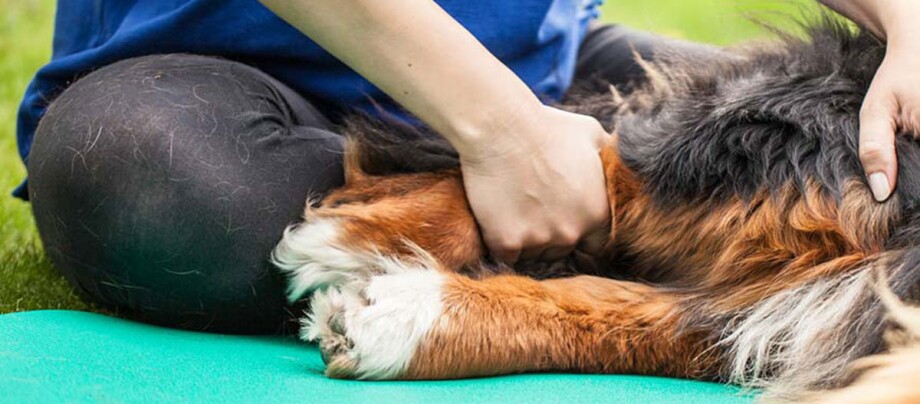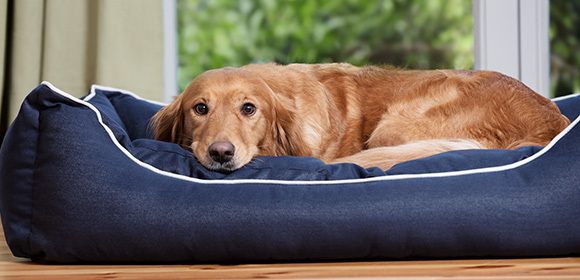Dogs with Arthrosis – Preventing and Treating Joint Problems in Dogs
07.10.2022 - Reading time: 7 minutes

Dogs with osteoarthritis suffer from a disease, possibly chronic, of the joints that is often not recognised and diagnosed in time. It is often said that only large dog breeds are affected by osteoarthritis, but this is not the case. Just like us humans, unfortunately, every dog can have joint problems and osteoarthritis in dogs has become a very common dog disease.
- The common dog disease osteoarthritis
- What exactly is osteoarthritis in dogs?
- Recognising symptoms of osteoarthritis
- Diagnostics at the vet
- Therapy options for dogs
- Surgery – the last resort
- Focus on dog nutrition
- Prevent joint problems in good time
- Preventive measures against arthrosis
- Joint-friendly games
The common dog disease osteoarthritis
Statistically, every fifth dog suffers from this joint disease. This degenerative change of the joints cannot be cured. But the sooner you recognise the symptoms, the greater the chances of a long and pain-free dog life with osteoarthritis.
We explain osteoarthritis in dogs and show you the therapeutic treatment options.
What exactly is osteoarthritis in dogs?
The term “arthrosis” covers various diseases that cause degenerative and painful changes in the joints.
Canine osteoarthritis is therefore a chronic pathological process, in the course of which the joint tissue (cartilage) is destroyed. This mainly affects the hip joints, but also the joints of the spine and the leg joints.
Veterinarians as well as human doctors call it arthrosis deformans. A distinction must be made between primary and secondary arthrosis.
Primary and secondary osteoarthritis
- Primary osteoarthritis is a (relatively rare) genetic joint disease that degenerates the dog’s joint without warning, so to speak. It affects particular breeds that have a basic predisposition to joint problems. These include, above all, large dog breeds such as Great Danes, German Shepherds, Labradors or Golden Retrievers.
- Secondary osteoarthritis, which is much more common, characterises a joint disease that occurs as a result of canine hip dysplasia and even more frequently after inflammation of the dog’s joint, so-called arthritis.
- If the inflammation of the joint (arthritis) is not recognised or heals insufficiently, it can lead to chronic arthrosis in dogs as a late consequence. But torn cruciate ligaments and hereditary joint deformities (hip dysplasia) also have the potential to lead to chronic joint wear.
- Mechanical wear and tear of the joints with increasing age of the dog can also be responsible for painful joint problems.
- Other factors that can cause osteoarthritis include: poor diet and heavy/incorrect joint stress, incorrect medication, toxins, joint surgery, overweight dogs and bone diseases such as osteoporosis in puppies or young dogs.
But whether it is a Great Dane, a German Shepherd or a Dachshund – dog arthritis can unfortunately affect any of our four-legged friends. It is important that you do not blame yourself as the owner.
Unlike arthritis – the acute disease of the joint due to inflammation – chronic osteoarthritis in dogs is not curable. Unnoticed and untreated, it continues to progress, the joint cartilage is completely used up and now bone rubs against bone.
The motor ability, i.e. rolling, stretching and bending of the dog’s joints, depends crucially on the condition of the joint capsules, articular cartilage and synovial fluid.
The joint capsule fulfils a protective function:
- The articular cartilage cushions the bone at the stressed sliding point.
- At the same time, the synovial fluid in the joint capsule functions like “lubrication” and thus ensures smooth movement at the cartilage itself. It also supplies the cartilage with nutrients and thus ensures its structure and elasticity.
In the course of chronic arthrosis, the protective cartilage changes and at the same time the synovial fluid decreases. This change can already begin during acute arthritis. The cartilage becomes more porous, uneven, harder, breaks down and eventually degrades completely, allowing the bones to rub against each other. The vicious circle begins when persistent joint inflammation or genetic predisposition leads to reduced production of synovial fluid, which means that the joint cartilage lacks nutrients that build it up and the joint is not sufficiently “lubricated”.

Recognise the symptoms of arthritis in your dog and have it diagnosed by a vet.
Can your dog only leave his dog bed with effort? Does he find it difficult to climb stairs? Or does he have difficulty jumping out of the car?
If you answered yes to these questions, then you should take your four-legged friend to a specialist veterinary clinic or a veterinarian who specialises in joint problems in dogs as soon as possible. The veterinarians will take a stress-free look at your dog via video chat and can make sound recommendations for further treatment after a detailed discussion with you. Appointments are made quickly and without waiting times online.
Osteoarthritis in dogs and the severity of the disease can be seen in the specific problems of your dog’s musculoskeletal system.
However, this is aggravated by the fact that dogs hide their pain for a long time or show it in an unspecific way, which sometimes makes it difficult for the dog owner to recognise the signs of osteoarthritis in time.
Recognise joint problems in the dog:
- The dog finds it difficult to get up from its bed, especially in the morning.
- Stiffness of the limbs, especially the hips or spine (curved back)
- Start-up difficulties after rest periods
- Constant or temporary lameness of individual limbs
- Swollen or hardened joints
- Yelping when touched or unwilling the affected areas (back, legs, hips) to be touched.
- Protection of the affected joints
- General reluctance to move
- Overheated and swollen joint areas, possibly reddened (in acute inflammation)
All symptoms can occur in both older and younger dogs. They are not synonymous with “natural” ageing processes, but give clear indications of a chronic, painful disease such as arthrosis in dogs.
Typical of chronic joint problems in dogs is the so-called “initial phase”, in which the dog first displays movement problems and reluctance to move, but these improve during a walk.
Diagnostics at the vet
At the veterinary practice, apart from the necessary blood values, which can provide information about possible inflammations, above all the condition of the joints is checked. X-rays of the joint areas in question are indispensable and represent the first step in the diagnosis. On the basis of the X-rays, the veterinarian can assess the position and condition of the joint bone, recognise cartilage and measure it.
To see if your dog’s joints are not overloaded by other factors, the vet can determine the so-called Body Condition Store. This shows – just like the BMI in humans – the muscular condition of your dog. In particular, the percentage of fat on the dog’s body is measured. The BCS is given in 5 levels. Level 3 is ideal for dogs with arthrosis and should be maintained for the long-term so that the joints are not additionally stressed by the dog’s excess weight.
Diagnosis of osteoarthritis and conventional medical treatment options for dogs
If the vet has diagnosed your dog with chronic joint wear and tear, perhaps accompanied by joint inflammation, the first thing to do is to eliminate the dog’s pain. To do this, the vet will give him an appropriate painkiller. In the case of joint inflammation, anti-inflammatory drugs are also given.

Treatment with painkillers (analgesics)
Treatment with painkillers is essential to get your dog to stop favouring the affected joints and start using all joints in a balanced way. This in turn promotes the production of important synovial fluid and relieves pressure on other joints.
Unfortunately, painkillers (analgesics) put a strain on the stomach. If your dog has to take so-called NSAIDs (non-steroidal anti-inflammatory drugs without cortisone) over a longer period of time, you should not take any risks and at the same time administer a stomach-protecting drug, proton pump inhibitors. This will protect your dog from stomach ulcers or even gastric perforation due to painkiller intolerance.
If chronic arthrosis is accompanied by arthritis, which in turn promotes arthrosis, this must be cured immediately and completely. In this case, the vet may give your dog an additional cortisone medication. To avoid the side effects of cortisone, a direct injection into the affected joint is definitely preferable to a cortisone tablet.
Surgery – the last resort
In cases of severe and advanced joint problems such as hip dysplasia in dogs, surgery should be considered to remove possible bone chips from the joint capsule or even to insert an artificial joint. This should definitely be discussed with a specialist and carried out in an appropriate veterinary clinic.
Relief or cure? Focus on dog nutrition
Most dog owners know that the food their four-legged friend eats has a great influence on the condition of the joints and the immune system, and thus on the inflammatory foci in the joints.
If your dog is overweight, it is important to put him on a diet. The vet can recommend a special food for dogs with joint problems. But regular exercise is an essential part of lasting weight reduction. In the case of arthritis in dogs, the daily exercise must be adapted to the needs and possibilities of your dog, depending on the stage of the disease. However, even if your dog has joint disease (but is pain-free!), do not forego extensive exercise sessions, because in the long run they are good medicine in themselves.
To get out of the vicious cycle of joint inflammation and wear, your dog needs a balanced diet.
The feed should have the following properties:
- Free from genetically modified components (common in maize).
- Made from high-quality, gently processed – preferably fresh – proteins (meat).
- Completely free of salts, preservatives, sugar and other flavour enhancers.
- Wheat products are equally taboo, as they can weaken the dog’s intestines, which in turn leads to inflammation in the dog’s body.
Some vitamin and trace element supplements that are fed to dogs have been successful in treating osteoarthritis. Be sure to consult your vet, because too much of a good thing can have a negative effect.
Useful feed supplements include the administration of:
- Omega-3 fatty acids (linseed and fish oil)
- Vitamins C, E and selenium (antioxidants) with anti-inflammatory, partly analgesic effect
- Glucosamine and chondroitin sulphate (green-lipped muscle extract), which are equally components of the joint cartilage and joint fluid.
- Collagen type I for regeneration of joint cartilage
- Hyaluronic acid for improved gliding of the joint cartilage
- Lysozyme, the enzyme as catalyst and activator of the immune system with anti-inflammatory effect
- Standardised feed supplements for diseased dog joints, such as “Ovomet”

Preventing joint problems in dogs in good time – is that possible?
Although you cannot stop a genetically determined, so-called primary arthrosis, you can alleviate the symptoms of your dog’s arthrosis considerably. The sooner countermeasures are started, the better. This is especially true for so-called secondary arthrosis, which is the result of other joint diseases, incorrect feeding, lack of exercise or excessive pressure to move.
Preventive measures against osteoarthritis in dogs include:
Weight loss
Growth disorders
Breed and age-appropriate handling of your dog
Overload
Jumps
Sleeping and lying underlay
Tips for joint-friendly games for young dogs, arthritic dogs and seniors
For young or old dogs, or even those with joint-diseases, those games that are easy on the joints and promote the dog’s mobility without putting strain on the joints are particularly suitable.
Case studies
Search games
Water games
As you can see, with the necessary knowledge, the support of your vet and your empathy, there is almost nothing to prevent your dog from leading a balanced life with osteoarthritis.


